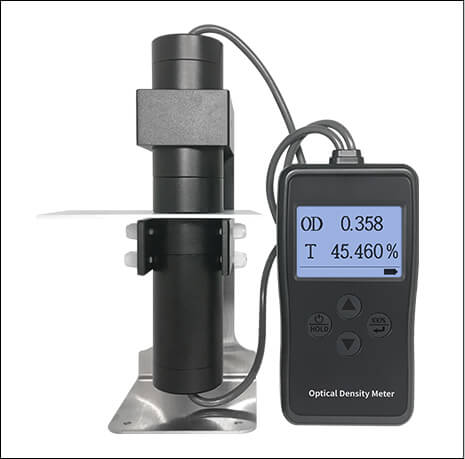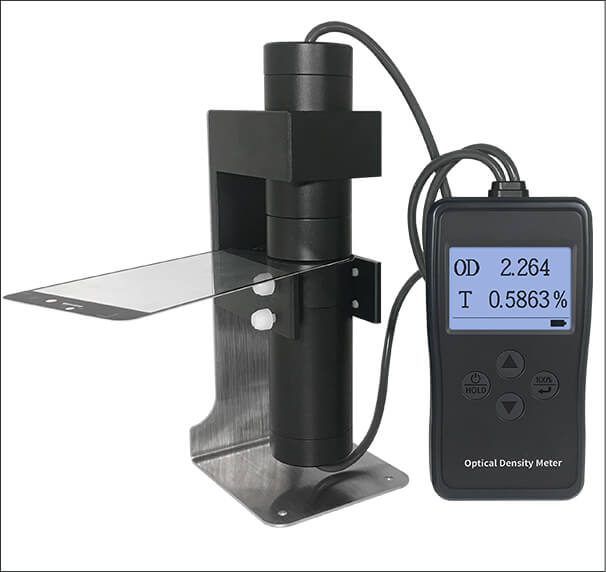
86117 Optical Density Meter
Suitable for testing opalescent translucent materials
Visible light transmittance and optical density can be measured simultaneously
Measuring accurately, and ensure it can pass the inspection of Chinese national authoritative metrology institute
86117 densitometer is an instrument that can measure both optical density and light transmittance. The instrument adopt the diffuse transmission principle which is suitable for the optical density test of opalescent translucent materials and frosted matte materials. The light source of the instrument complies with the CIE photopic luminosity function and can pass the inspection of Chinese national metrological institute
Application
Suitable for testing optical density of aluminized film, film, X-ray film, lens ink and other materials. The optical density meter is suitable for testing the light transmittance of opalescent translucent materials, matte materials.






Parameters
| Parameter | Value |
|---|---|
| Light Transmittance Measurement Accuracy | ±1% (0%-50%) ±2% (50%-100%) |
| Light Transmittance Resolution | 0.0005% (0%-10%) 0.005% (10% -100%) |
| Optical Density Measurement Tange | 0.000OD-6.000OD |
| Optical Density Measurement Accuracy | ±0.02 (0-2.00OD) ±2% (2.00-6.00OD) |
| Optical Density Resolution | 0.001 OD (0.00-2.00OD) 0.01 OD (2.00-4.00OD) 0.1 OD (4.00-6.00OD) |
| Aperture | 2mm |
| Light Source | 380nm-760nm, conforming to CIE photopic luminosity function |
| Weight | About 576g (without battery) |
| Power Supply | 4*AAA alkaline dry battery |
| Display | 240*160 dot-matrixes LCD |
| Dimension | 148mm×76mm×26mm (L*W*H) |

Features
High resolution, wide optical density measurement range
The optical density meter has wide measuring range. The optical density value can be measured to OD 6. The transmittance resolution is up to 0.005%
Light transmittance and optical density are measured simultaneously
During the test, the interface displays both the transmittance value and the optical density value of the material

Diffuse transmission light path design
The 86117 portable densitometer uses a diffuse transmission light path design, which has the same effect of the integrating sphere. There are relevant instructions in "GB / T 11500-2008 / ISO 5-2: 2001". The regulation has stated that “Use opale glass method instead of integrating sphere method as the basis of ISO standard diffuse transmission density&quot
Two measurement ways for more flexible to use
The optical density meter has two measurement methods which is more flexible to use.
Fixed measurement: It is more suitable for testing regular or smaller objects.
Hand-held measurement: take the probe down for testing, which is more suitable for irregular and large-volume materials

Pedestal measurement

Field measurement
Packing
| No. | Description | Quantity | Unit |
|---|---|---|---|
| 1 | 86117 Optical Density Meter | 1 | pcs |
| 2 | User Manual | 1 | pcs |
| 3 | Certificate / Warranty Card | 1 | pcs |
| 4 | Aluminum Box | 1 | pcs |
| 5 | Packing Box Dimension 34*25*14 cm(L*W*H) | 1 | pcs |

FAQ
-
1. The difference between 86117 and 86116
86116 is suitable for measuring the light transmittance of transparent and regular materials. The diameter of the tested material must be greater than 10mm;
86117 is mainly suitable for measuring the light transmittance of opalescent, frosted fog, diffuse transmission materials and low-transmittance materials (at the same time it can measure the optical density value).The diameter of the measured material should be greater than 2mm.
-
2. What is the maximum sample thickness that 86117 light transmittance meter can measure?
The 86117 light transmittance meter (optical density meter) use a point light source. Generally speaking, the smaller the tested material thickness, the more accurate the test result. It is not recommended to measure materials with a thickness that more than 2mm.
-
3. How to calibrate 86117 and how often does it need to be calibrated?
The 86117 light transmittance meter (optical density meter) has a real-time dynamic self-calibration function and does not require other tools such as standard films to assist in calibration. Without placing any material under test, as long as the instrument passes self-calibration and displays 100%, the light transmittance test can be performed. The instrument accuracy is also guaranteed to meet the factory standards.